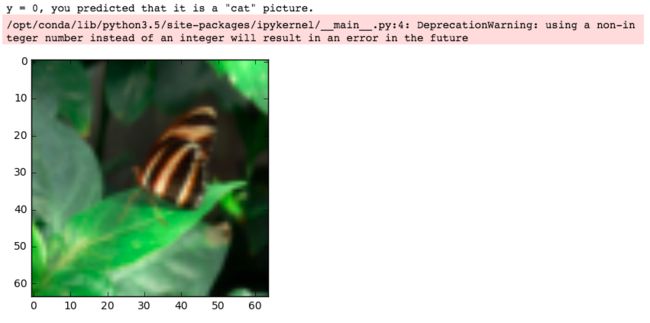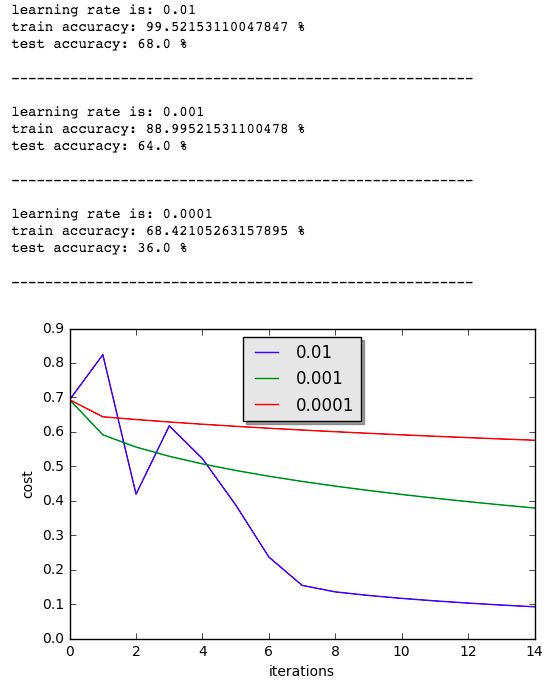本文结构:
- 将 Logistic 表达为 神经网络 的形式
- 构建模型
- 导入包
- 获得数据
- 并进行预处理: 格式转换,归一化
- 整合模型:
- A. 构建模型
- a. 初始化参数:w 和 b 为 0
- b. 前向传播:计算当前的损失
- c. 反向更新:计算当前的梯度
- B. 梯度更新求模型参数
- C. 进行预测
- A. 构建模型
- 绘制学习曲线
1. 将 Logistic 表达为 神经网络 的形式
本文的目的是要用神经网络的思想实现 Logistic Regression,输入一张图片就可以判断该图片是不是猫。
那么什么是神经网络呢?
可以看我之前写的这篇文章:
什么是神经网络
其中一个很重要的概念,神经元:
再来看 Logistic 模型的表达:
那么把 Logistic 表达为 神经网络 的形式为:
(关于 Logistic 可以看这两篇文章:
Logistic Regression 为什么用极大似然函数
Logistic regression 为什么用 sigmoid ?)
接下来就可以构建模型:
2. 构建模型
我们的目的是学习 和 使 cost function 达到最小,
方法就是:
- 通过前向传播 (forward propagation) 计算当前的损失,
- 通过反向传播 (backward propagation) 计算当前的梯度,
- 再用梯度下降法对参数进行优化更新 (gradient descent)
关于反向传播可以看这两篇文章:
手写,纯享版反向传播算法公式推导
构建模型,训练模型,并进行预测,包含下面几步:
- 导入包
- 获得数据
- 并进行预处理: 格式转换,归一化
- 整合模型:
- A. 构建模型
- a. 初始化参数:w 和 b 为 0
- b. 前向传播:计算当前的损失
- c. 反向更新:计算当前的梯度
- B. 梯度更新求模型参数
- C. 进行预测
- A. 构建模型
- 绘制学习曲线
下面进入详细代码:
1. 导入包
引入需要的 packages,
其中,
h5py 是 python 中用于处理 H5 文件的接口,
PIL 和 scipy 在本文是用自己的图片来测试训练好的模型,
load_dataset 读取数据
import numpy as np
import matplotlib.pyplot as plt
import h5py
import scipy
from PIL import Image
from scipy import ndimage
from lr_utils import load_dataset
%matplotlib inline
其中 lr_utils.py 如下,是对 H5 文件进行解析 :
#lr_utils.py
import numpy as np
import h5py
def load_dataset():
train_dataset = h5py.File('datasets/train_catvnoncat.h5', "r")
train_set_x_orig = np.array(train_dataset["train_set_x"][:]) # your train set features
train_set_y_orig = np.array(train_dataset["train_set_y"][:]) # your train set labels
test_dataset = h5py.File('datasets/test_catvnoncat.h5', "r")
test_set_x_orig = np.array(test_dataset["test_set_x"][:]) # your test set features
test_set_y_orig = np.array(test_dataset["test_set_y"][:]) # your test set labels
classes = np.array(test_dataset["list_classes"][:]) # the list of classes
train_set_y_orig = train_set_y_orig.reshape((1, train_set_y_orig.shape[0]))
test_set_y_orig = test_set_y_orig.reshape((1, test_set_y_orig.shape[0]))
return train_set_x_orig, train_set_y_orig, test_set_x_orig, test_set_y_orig, classes
2. 获得数据
# Loading the data (cat/non-cat)
train_set_x_orig, train_set_y, test_set_x_orig, test_set_y, classes = load_dataset()
可以看一下图片的例子:
# Example of a picture
index = 25
plt.imshow(train_set_x_orig[index])
print ("y = " + str(train_set_y[:,index]) + ", it's a '" + classes[np.squeeze(train_set_y[:,index])].decode("utf-8") + "' picture.")
3. 进行预处理: 格式转换,归一化
这时需要获得下面几个值:
- m_train (训练样本数量)
- m_test (测试样本数量)
- num_px (训练数据集的长和宽)
### START CODE HERE ### (≈ 3 lines of code)### STA
m_train = train_set_y.shape[1]
m_test = test_set_y.shape[1]
num_px = train_set_x_orig.shape[1]
### END CODE HERE ###
print ("Number of training examples: m_train = " + str(m_train))
print ("Number of testing examples: m_test = " + str(m_test))
print ("Height/Width of each image: num_px = " + str(num_px))
print ("Each image is of size: (" + str(num_px) + ", " + str(num_px) + ", 3)")
print ("train_set_x shape: " + str(train_set_x_orig.shape))
print ("train_set_y shape: " + str(train_set_y.shape))
print ("test_set_x shape: " + str(test_set_x_orig.shape))
print ("test_set_y shape: " + str(test_set_y.shape))
图像需要进行 reshape,原本是 (num_px, num_px, 3),要扁平化为一个向量 (num_px * num_px * 3, 1),
将 (a, b, c, d) 维的矩阵转换为 (b∗c∗d, a) 可以用: X_flatten = X.reshape(X.shape[0], -1).T
# Reshape the training and test examples
### START CODE HERE ### (≈ 2 lines of code)
train_set_x_flatten = train_set_x_orig.reshape(train_set_x_orig.shape[0], -1).T
test_set_x_flatten = test_set_x_orig.reshape(test_set_x_orig.shape[0], -1).T
### END CODE HERE ###
print ("train_set_x_flatten shape: " + str(train_set_x_flatten.shape))
print ("train_set_y shape: " + str(train_set_y.shape))
print ("test_set_x_flatten shape: " + str(test_set_x_flatten.shape))
print ("test_set_y shape: " + str(test_set_y.shape))
print ("sanity check after reshaping: " + str(train_set_x_flatten[0:5,0]))
预处理还常常包括对数据进行中心化和标准化,图像数据的话,可以简单除以最大的像素值:
train_set_x = train_set_x_flatten / 255.
test_set_x = test_set_x_flatten / 255.
4. 整合模型
- A. 构建模型
- a. 初始化参数:w 和 b 为 0
- b. 前向传播:计算当前的损失
- c. 反向更新:计算当前的梯度
- B. 梯度更新求模型参数
- C. 进行预测
先来 A. 构建模型
按照前面提到的三步:
初始化参数:w 和 b 为 0
前向传播:计算当前的损失
反向更新:计算当前的梯度
首先需要一个辅助函数 sigmoid( w^T x + b)
# GRADED FUNCTION: sigmoid
def sigmoid(z):
"""
Compute the sigmoid of z
Arguments:
x -- A scalar or numpy array of any size.
Return:
s -- sigmoid(z)
"""
### START CODE HERE ### (≈ 1 line of code)
s = 1 / (1 + np.exp(-z))
### END CODE HERE ###
return s
a. 初始化参数:w 和 b 为 0
# GRADED FUNCTION: initialize_with_zeros
def initialize_with_zeros(dim):
"""
This function creates a vector of zeros of shape (dim, 1) for w and initializes b to 0.
Argument:
dim -- size of the w vector we want (or number of parameters in this case)
Returns:
w -- initialized vector of shape (dim, 1)
b -- initialized scalar (corresponds to the bias)
"""
### START CODE HERE ### (≈ 1 line of code)
w = np.zeros(shape=(dim, 1))
b = 0
### END CODE HERE ###
assert(w.shape == (dim, 1))
assert(isinstance(b, float) or isinstance(b, int))
return w, b
b. 前向传播:计算当前的损失
c. 反向更新:计算当前的梯度
# GRADED FUNCTION: propagate
def propagate(w, b, X, Y):
"""
Implement the cost function and its gradient for the propagation explained above
Arguments:
w -- weights, a numpy array of size (num_px * num_px * 3, 1)
b -- bias, a scalar
X -- data of size (num_px * num_px * 3, number of examples)
Y -- true "label" vector (containing 0 if non-cat, 1 if cat) of size (1, number of examples)
Return:
cost -- negative log-likelihood cost for logistic regression
dw -- gradient of the loss with respect to w, thus same shape as w
db -- gradient of the loss with respect to b, thus same shape as b
Tips:
- Write your code step by step for the propagation
"""
m = X.shape[1]
# FORWARD PROPAGATION (FROM X TO COST)
### START CODE HERE ### (≈ 2 lines of code)
A = sigmoid(np.dot(w.T, X) + b) # compute activation
cost = (- 1 / m) * np.sum(Y * np.log(A) + (1 - Y) * (np.log(1 - A))) # compute cost
### END CODE HERE ###
# BACKWARD PROPAGATION (TO FIND GRAD)
### START CODE HERE ### (≈ 2 lines of code)
dw = (1 / m) * np.dot(X, (A - Y).T)
db = (1 / m) * np.sum(A - Y)
### END CODE HERE ###
assert(dw.shape == w.shape)
assert(db.dtype == float)
cost = np.squeeze(cost)
assert(cost.shape == ())
grads = {"dw": dw,
"db": db}
return grads, cost
B. 梯度更新求模型参数
这一步 optimize 的目的是要学习 和 使 cost function 达到最小,
用到的方法是梯度下降 ,
# GRADED FUNCTION: optimize
def optimize(w, b, X, Y, num_iterations, learning_rate, print_cost = False):
"""
This function optimizes w and b by running a gradient descent algorithm
Arguments:
w -- weights, a numpy array of size (num_px * num_px * 3, 1)
b -- bias, a scalar
X -- data of shape (num_px * num_px * 3, number of examples)
Y -- true "label" vector (containing 0 if non-cat, 1 if cat), of shape (1, number of examples)
num_iterations -- number of iterations of the optimization loop
learning_rate -- learning rate of the gradient descent update rule
print_cost -- True to print the loss every 100 steps
Returns:
params -- dictionary containing the weights w and bias b
grads -- dictionary containing the gradients of the weights and bias with respect to the cost function
costs -- list of all the costs computed during the optimization, this will be used to plot the learning curve.
Tips:
You basically need to write down two steps and iterate through them:
1) Calculate the cost and the gradient for the current parameters. Use propagate().
2) Update the parameters using gradient descent rule for w and b.
"""
costs = []
for i in range(num_iterations):
# Cost and gradient calculation (≈ 1-4 lines of code)
### START CODE HERE ###
grads, cost = propagate(w, b, X, Y)
### END CODE HERE ###
# Retrieve derivatives from grads
dw = grads["dw"]
db = grads["db"]
# update rule (≈ 2 lines of code)
### START CODE HERE ###
w = w - learning_rate * dw # need to broadcast
b = b - learning_rate * db
### END CODE HERE ###
# Record the costs
if i % 100 == 0:
costs.append(cost)
# Print the cost every 100 training examples
if print_cost and i % 100 == 0:
print ("Cost after iteration %i: %f" % (i, cost))
params = {"w": w,
"b": b}
grads = {"dw": dw,
"db": db}
return params, grads, costs
C. 进行预测
# GRADED FUNCTION: predict
def predict(w, b, X):
'''
Predict whether the label is 0 or 1 using learned logistic regression parameters (w, b)
Arguments:
w -- weights, a numpy array of size (num_px * num_px * 3, 1)
b -- bias, a scalar
X -- data of size (num_px * num_px * 3, number of examples)
Returns:
Y_prediction -- a numpy array (vector) containing all predictions (0/1) for the examples in X
'''
m = X.shape[1]
Y_prediction = np.zeros((1, m))
w = w.reshape(X.shape[0], 1)
# Compute vector "A" predicting the probabilities of a cat being present in the picture
### START CODE HERE ### (≈ 1 line of code)
A = sigmoid(np.dot(w.T, X) + b)
### END CODE HERE ###
for i in range(A.shape[1]):
# Convert probabilities a[0,i] to actual predictions p[0,i]
### START CODE HERE ### (≈ 4 lines of code)
Y_prediction[0, i] = 1 if A[0, i] > 0.5 else 0
### END CODE HERE ###
assert(Y_prediction.shape == (1, m))
return Y_prediction
下面为整合的逻辑回归模型:
将参数初始化,优化求参,预测整合在一起,
输入为 训练集,测试集,迭代次数,学习速率,是否打印中间损失
打印 test 和 train 集的预测准确率
返回的 d 含有 参数 w,b,还有 test train 集上面的预测值,
# GRADED FUNCTION: model
def model(X_train, Y_train, X_test, Y_test, num_iterations=2000, learning_rate=0.5, print_cost=False):
"""
Builds the logistic regression model by calling the function you've implemented previously
Arguments:
X_train -- training set represented by a numpy array of shape (num_px * num_px * 3, m_train)
Y_train -- training labels represented by a numpy array (vector) of shape (1, m_train)
X_test -- test set represented by a numpy array of shape (num_px * num_px * 3, m_test)
Y_test -- test labels represented by a numpy array (vector) of shape (1, m_test)
num_iterations -- hyperparameter representing the number of iterations to optimize the parameters
learning_rate -- hyperparameter representing the learning rate used in the update rule of optimize()
print_cost -- Set to true to print the cost every 100 iterations
Returns:
d -- dictionary containing information about the model.
"""
### START CODE HERE ###
# initialize parameters with zeros (≈ 1 line of code)
w, b = initialize_with_zeros(X_train.shape[0])
# Gradient descent (≈ 1 line of code)
parameters, grads, costs = optimize(w, b, X_train, Y_train, num_iterations, learning_rate, print_cost)
# Retrieve parameters w and b from dictionary "parameters"
w = parameters["w"]
b = parameters["b"]
# Predict test/train set examples (≈ 2 lines of code)
Y_prediction_test = predict(w, b, X_test)
Y_prediction_train = predict(w, b, X_train)
### END CODE HERE ###
# Print train/test Errors
print("train accuracy: {} %".format(100 - np.mean(np.abs(Y_prediction_train - Y_train)) * 100))
print("test accuracy: {} %".format(100 - np.mean(np.abs(Y_prediction_test - Y_test)) * 100))
d = {"costs": costs,
"Y_prediction_test": Y_prediction_test,
"Y_prediction_train" : Y_prediction_train,
"w" : w,
"b" : b,
"learning_rate" : learning_rate,
"num_iterations": num_iterations}
return d
下面代码进行模型训练:
d = model(train_set_x, train_set_y, test_set_x, test_set_y, num_iterations = 2000, learning_rate = 0.005, print_cost = True)
结果:
Cost after iteration 0: 0.693147
Cost after iteration 100: 0.584508
Cost after iteration 200: 0.466949
Cost after iteration 300: 0.376007
Cost after iteration 400: 0.331463
Cost after iteration 500: 0.303273
Cost after iteration 600: 0.279880
Cost after iteration 700: 0.260042
Cost after iteration 800: 0.242941
Cost after iteration 900: 0.228004
Cost after iteration 1000: 0.214820
Cost after iteration 1100: 0.203078
Cost after iteration 1200: 0.192544
Cost after iteration 1300: 0.183033
Cost after iteration 1400: 0.174399
Cost after iteration 1500: 0.166521
Cost after iteration 1600: 0.159305
Cost after iteration 1700: 0.152667
Cost after iteration 1800: 0.146542
Cost after iteration 1900: 0.140872
train accuracy: 99.04306220095694 %
test accuracy: 70.0 %
得到模型后可以看指定 index 所代表图片的预测值:
# Example of a picture that was wrongly classified.# Exampl
index = 5
plt.imshow(test_set_x[:,index].reshape((num_px, num_px, 3)))
print ("y = " + str(test_set_y[0, index]) + ", you predicted that it is a \"" + classes[d["Y_prediction_test"][0, index]].decode("utf-8") + "\" picture.")
5. 绘制学习曲线
# Plot learning curve (with costs)# Plot l
costs = np.squeeze(d['costs'])
plt.plot(costs)
plt.ylabel('cost')
plt.xlabel('iterations (per hundreds)')
plt.title("Learning rate =" + str(d["learning_rate"]))
plt.show()
可以看出 costs 是在下降的,如果增加迭代次数,那么训练数据的准确率会进一步提高,但是测试数据集的准确率可能会明显下降,这就是由于过拟合造成的。
还可以对比下不同学习率对应下的学习效果:
learning_rates = [0.01, 0.001, 0.0001]
models = {}
for i in learning_rates:
print ("learning rate is: " + str(i))
models[str(i)] = model(train_set_x, train_set_y, test_set_x, test_set_y, num_iterations = 1500, learning_rate = i, print_cost = False)
print ('\n' + "-------------------------------------------------------" + '\n')
for i in learning_rates:
plt.plot(np.squeeze(models[str(i)]["costs"]), label= str(models[str(i)]["learning_rate"]))
plt.ylabel('cost')
plt.xlabel('iterations')
legend = plt.legend(loc='upper center', shadow=True)
frame = legend.get_frame()
frame.set_facecolor('0.90')
plt.show()
当学习率过大 (例 0.01) 时,costs 出现上下震荡,甚至可能偏离,不过这里 0.01 最终幸运地收敛到了一个比较好的值。
推荐阅读 历史技术博文链接汇总
http://www.jianshu.com/p/28f02bb59fe5
也许可以找到你想要的:
[入门问题][TensorFlow][深度学习][强化学习][神经网络][机器学习][自然语言处理][聊天机器人]








